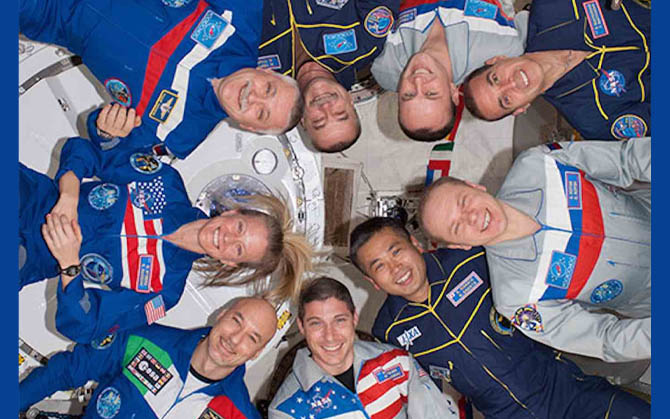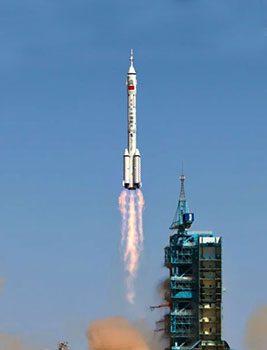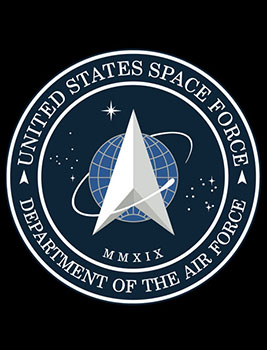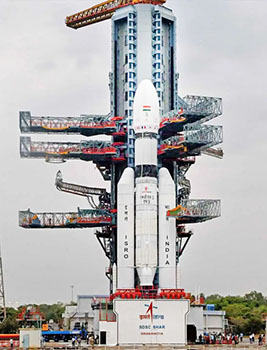
Download PDF Here
Live Encounters Magazine April 2023
Space Policy: The Unknown Beckons and a Strategic Plan Matters
by Dr. Namrata Goswami

We want to go to space! Escape Earth’s gravity, get to its orbits, and then travel to cislunar (space between Earth and Moon), establish a presence on the Moon, and then utilize the Moon as our eighth continent and venture out into our solar system. Indeed, that is what encompasses space beyond the orbits and the gravitational pull of the Earth-Moon zone. It appears as a dark void, and yet the unknown does call to us. Earth itself is a spaceship, which for now, is the only habitable planet in our solar system. We may know of Earth like planets that might sustain life in other solar systems, and even if we do,[1] we might not be able to ever know or visit them given the enormous distances.[2]
Despite knowing full well, the reality of such vast distances, the imagination of space and what it holds, has ignited human civilization with a mysterious longing, and a spiritual realization that we are, after-all, a part of what we call the universe. In some sense, we are connected to that universal core. This has led to missions of star gazing, exploration, scientific discovery and a movement to become interplanetary. Until now, human civilization has been able to get to its Moon, but travel beyond that has not come easy, and we have been confined to sending robotic missions to distant planets.
All these space ambitions, aspirations and goals have been conceived by different nations and their societies for divergent reasons, some for geopolitical reasons, others for showing off technology, and now with a potential to utilize the resources of the Moon, Mars and asteroids for human space development.
Space education has become an important component of the sciences and the arts, from the physical, life to the social sciences; the understanding of human behavior and motivations, the passions and the deeper need to expand ourselves and our descendants into the universe beyond Earth. There are those who argue for an expansionist vision including myself,[3] and then there are those who argue for an Earth confined human civilization given the potential for planetary degradation that the human species is accused of.[4] I argue that human civilization is capable of progress and that we are not doomed to repeat the mistakes of the past.
Into this grand meta-narrative, enters the idea of space policy, and what it involves. The Cambridge dictionary defines policy as “a set of ideas or a plan of what to do in particular situations that has been agreed to officially by a group of people, a business organization, a government, or a political party”.[5] “Public policy can be generally defined as a system of laws, regulatory measures, courses of action, and funding priorities concerning a given topic promulgated by a governmental entity or its representatives.”[6] In this, we can have policy advocacy groups, educational institutions, public intellectuals, and competing interest groups and institutions that might aim to shape the policy process to their interest.
I define space policy as a process of developing, prioritizing and implementing a plan f action developed by the government entity entrusted with the task. In the U.S. the National Space Council (NSpC) coordinates the development of the national space policy in consultation with different government departments. Simply put, this is an inter-agency process, which means that different departments might have their own set of priorities in regard to a national level space policy.[7]

In China, the State Council of the People’s Republic of China (PRC) writes the space policies and produces the White Papers on Space Activities,[8] but the policy process involves other institutions like the China National Space Administration (CNSA), the China Academy of Space Technology (CAST), the China Aerospace Science and Technology Corporation (CASC), the Shanghai Academy of Spaceflight Technology
(SAST), the Chinese Academy of Sciences (CAS), the Chinese Academy of Military Sciences (AMS) amongst others. A similar process is followed in India with the Department of Space (DoS) that is located within the Prime Minister’s office setting the policy, with new institutions like the New Space India Limited (NSIL) inaugurated in 2019 to bring in the voices of the commercial sector.[9]
So, how does the space policy process actually work? The first stage is problem identification; the second stage is policy formulation, the third stage is policy adoption, the fourth stage is policy implementation, and finally, policy evaluation.[10] Let us now define these stages and illustrate it through examples.
Policy in democratic settings require elite consensus, societal cohesion and support and leadership to push it forward. The first stage in the policy process is identification of a problem, be it organizationally, or a technology, that requires to be built to forward a particular policy goal. Sometimes even if an organization already exist, for example like NASA, it might not be optimized to do some of the tasks set by a space policy directive, or have the organizational flexibility to adapt quickly to certain key strategic goals. Like deterrence and protection of U.S. space assets in LEO or GEO. Or NASA might not be optimized to invest in space resource extraction and development, being focused since the end of the Cold War on space science and space exploration missions.

Even to use policy words like space development which changes the narrative from space exploration can be a difficult process to adapt to. Given that, a space policy process can identify that as a problem and call for new organizational structures like the U.S. did in terms of developing a NSpC whose mandate is far larger and broader than NASA and to develop a dedicated military service for space deterrence like the U.S. Space Force (USSF) in 2019.[11]
China initiated a space policy process through their White Papers and developed their own PLA Strategic Support Force (PLASSF) in 2015 to address issues like joint warfare training and capability. India identified the absence of a supportive space eco system for the development of its commercial space sector and consequently developed new institutions like the NSIL and the Indian National Space Promotion and Authorization Center to help coordinate, legislate and develop the regulatory and institutional structures to resolve the problem of absence of such supportive structures.
The second stage in the space policy process is policy formulation. This is the stage where once a problem area has been identified, states then formulate specific policies to address these issues. For China, the formulation of policy to develop reusable rockets and cislunar space capabilities is addressed in its 2021 White Paper on Space Activities.[12]
For the U.S., developing capabilities for space exploration and space science including the Moon is formulated in its 2020 National Space Policy,[13] its 2021 Space Priorities Framework[14] and its cislunar strategy.[15] The United Arab Emirates has issued a national space policy that is focused on developing its national space program with a priority on enhancing UAE internal space capabilities, international collaboration as a member of the U.S. led Artemis Accords,[16] and through signing Memorandum of Understandings (MoUs) with countries like Luxembourg to participate in the future of space resources extraction that Luxembourg is focused on.[17]
The third stage of the space policy process is policy adoption. In this stage, countries that have formulated a space policy goes about adopting the policy through for example, in the U.S. through Congressional approval, in China, through State Council policy adoption, in India, a parliamentary debate and budgetary approval, within the UAE, support from its own regime type. This step is crucial as it is during the adoption stage that an interagency process is key, and policy priorities are set, and missions can be either enhanced or diluted depending on which agency will play to its own strengths to ensure that space policy missions are within their own range of expertise and capabilities.
One could see this process play out during the U.S. policy adoption of Commercial Cargo and Commercial Crew Programs where some insiders within NASA were allegedly resistant to the idea given the fear that the commercial sector may take over some of the missions NASA felt entitled to carry through, to include developing a reusable rocket and supplies to the International Space Stations.[18]
Even today in the U.S. where there is a policy adoption of public-private partnership for space missions, it is pretty much a supplier of space technology mindset that the commercial space industry has adopted in the U.S. where systems they build have to be justified within the NASA overall preamble, for instance for a program like the Artemis Program with companies building the lunar landers and launchers, and the LunaNet support structure for NASA missions to the Moon.[19]
China’s policy adoption of developing its commercial space sector through its document 60 titled Guiding Opinions of the State Council on Innovating the Investment and Financing Mechanisms in Key Areas and Encouraging Social Investment issued by the State Council in 2014 went through a process of ensuring that these private space sectors were made keenly aware that they worked within the guidance of that document as well as the 2021 National Defense Law.[20]
Japan adopted a new Space Policy Framework in 2008 that focused on space development and utilization, gave priority to establishing space legislations that supported such a process and focused on developing Japanese citizens capabilities and skillset to benefit from the space commercial sector.[21] African nations developed a Statute for the development of the space sector through the African Union and called for the establishment of an African Space Agency to ensure that African nations benefit from space to include from the commercial development of space.[22]
The fourth stage in the space policy process is policy implementation. Once a policy is adopted, the policy has to be implemented by institutions tasked with it. If U.S. national security space policy calls for deterrence and security of U.S. space assets in Low Earth Orbit (LEO) and Geosynchronous Orbit (GEO), it will be the task of the USSF to implement such goals. When the U.S. adopted a space policy goal of going back to the Moon, and to develop sustainable presence on the Moon, it is the domain of NASA to ensure that those policy goals are met and that the policy is implemented.
When Presidents George W. Bush Jr and Barack Obama called for the commercial development of space as a policy goal, it fell to both NASA and the commercial space industry to develop and implement those goals. Implementation is the stage where budgets matter and how much is allocated for the actual building of missions, institutions, and end capacity.
When the African Space Agency was established in Egypt and budgetary allocations were made by African nations to build it, that policy had passed the implementation stage. When India adopted a policy of supporting its commercial space sector including making its launch systems (rockets) private, the establishment of institutions like NSIL, the allocation of budget to develop those capacities, and the offering of launch pads for the launch of India’s first commercial rocket are in the policy implementation stage. When Japan developed its own Space Domain Mission Unit in 2020 as part of national security space,[23] and announced its space mining legislation in December 2021 to support the commercial extraction of space resources,[24] these developments are within the policy implementation stage.
The final stage in the space policy process is policy evaluation. This is the stage where policies that have gone through the policy feedback loop are now in the final stage where we can evaluate how successful and/or how ineffective these policies were towards the goal of space exploration/development. For instance, it is at the policy evaluation stage that space missions like U.S. Artemis Accords for lunar development can be assessed for effectiveness, in terms of how many international partnerships is it able to procure, who are these international partners and what actual capacity do they bring to the program.

If some major space faring nations have not joined the Artemis Accords, for example, India, then this is the stage to assess why. In India’s case, the policy of sending missions to Moon and Mars, the slow adoption of an actual official space policy, the lack of clarity as to why India is against UN proposals for developing responsible behavior in space to include its voting record of abstention, should be explained by the Indian Department of Space within India’s space institutional structure, so that nations understand why India has adopted such a stand. Strategic ambiguity at the policy evaluation stage is not helpful.
The U.S. needs a policy evaluation for instance, of whether the establishment of the USSF has actually made the U.S. more secure in space, and what is the kind of culture, education, tactical and strategic mindsets and training, space officers are being exposed to, to make them successful guardians of space for the future. Policy evaluation must be based on both qualitative and quantitative analyses, to include financial assessments of which policy has succeeded in accomplishing its goals, within budget and on time, and if not, then an objective explanation on why that is the case.
In all of this, a grand strategic vision for why a state and society invests in space capability and why that matters must be clearly identified at the beginning stages even before problem identification. How grand strategic perspectives are adopted is of course determined and influenced by strategic culture, and political culture of a particular state and society. For instance, driven by China’s Comprehensive National Power (CNP), a concept inspired by Deng Xiaoping, and now adopted by President Xi Jinping within his ‘National rejuvenation’ framework, China has pushed for a particular set of problem identification, followed by the entire policy cycle of which institutions formulate, adopt, implement and evaluate which policy. Failures are discussed within a tight knit closed group without an external audit.
Till today, India has not issued a written official explanation of what happened with its Chandrayaan 2 mission based on scientific audit, as to why it failed in the last few seconds to land on the lunar surface, and what policy needs to be adopted to ensure that does not happen again in the future. That is why I say, political and strategic culture matters in the end of how the space policy process unfolds. Moreover, it can be messy in the real world and complicate the conceptual compartmentalization I identify here in this article.
Nevertheless, it is a useful mental model to keep reminding us that a clear policy plan is always useful to keep us on the path, since we as humans tend to deviate so often from what we set ourselves to accomplish, including in our own lives. States and societies are after all a representation of humans working together and/or competing on a grand scale, and they will reproduce many of the behaviors we see at the individual level, only with much more complexities and with much more resources to solve or exacerbate the problems of the day.
Vision and purpose of a space program is therefore the critical guiding light.
End Notes
[1] NASA, “Exoplanet Exploration Planet Beyond our Solar Systems”, https://exoplanets.nasa.gov/ (Accessed on March 22, 2023).
[2] Dustin Jones, “A Newly Discovered Planet 40% Larger than Earth May be Suitable for Life”, NPR, September 7, 2022, https://www.npr.org/2022/09/07/1121465588/new-planet-super-earth-life-nasa (Accessed on March 16, 2023).
[3] Namrata Goswami and Peter Garretson, Scramble for the Skies The Great Power Competition to Control the Resources of Outer Space (Lanham, MD: Lexington Press, 2020), at https://rowman.com/ISBN/9781498583114/Scramble-for-the-Skies-The-Great-Power-Competition-to-Control-the-Resources-of-Outer-Space (Accessed on March 20, 2023).
[4] Daniel Deudney, Dark Skies: Space Expansions, Planetary Geopolitics and the Ends of Humanity (Oxford: Oxford University Press, 2020).
[5] “Policy”, Cambridge University, https://dictionary.cambridge.org/us/dictionary/english/policy (Accessed on March 11, 2023).
[6] Dean G. Kilpatrick, “Definition of Public Policy and the Law”, https://mainweb-v.musc.edu/vawprevention/policy/definition.shtml (Accessed on March 11, 2023).
[7] National Space Council, The White House, https://www.whitehouse.gov/spacecouncil/ (Accessed on March 20, 2023).
[8] The State Council of the People’s Republic of China, https://english.www.gov.cn/ (Accessed on March 20, 2023).
[9] New Space India Ltd, https://www.nsilindia.co.in/ (Accessed on March 20, 2023).
[10] Paul A. Sabatier and Christopher M. Weible, eds, Theories of the Policy Process (London and New York: Routledge, 2017).
[11] United States Space Force History, https://www.spaceforce.mil/About-Us/About-Space-Force/History/#:~:text=USSF%20History,armed%20services%20in%2073%20years. (Accessed on March 20, 2023).
[12] China’s Space Program A 2021 Perspective, The State Council PRC, January 28, 2022, https://english.www.gov.cn/archive/whitepaper/202201/28/content_WS61f35b3dc6d09c94e48a467a.html (Accessed on March 20, 2023).
[13] Office of Space Commerce, National Space Policy, December 9, 2020, https://www.space.commerce.gov/policy/national-space-policy/ (Accessed on March 20, 2023).
[14] United States Space Priorities Framework, December 1, 2021, https://www.whitehouse.gov/wp-content/uploads/2021/12/united-states-space-priorities-framework-_-december-1-2021.pdf (Accessed on March 20, 2023).
[15] The White House, National Cislunar Science & Technology Strategy, November 2022, https://www.whitehouse.gov/wp-content/uploads/2022/11/11-2022-NSTC-National-Cislunar-ST-Strategy.pdf (Accessed on March 20, 2023).
[16] UAE National Space Strategy, https://u.ae/en/about-the-uae/strategies-initiatives-and-awards/strategies-plans-and-visions/industry-science-and-technology/national-space-strategy-2030#:~:text=The%20National%20Space%20Strategy%202030,presence%20in%20the%20space%20sector (Accessed on March 20, 2023).
[17] UAE Space Agency Sign MoU with Luxembourg, Times Aerospace, November 10, 2017, https://www.timesaerospace.aero/news/space/uae-space-agency-signs-mou-with-luxembourg (Accessed on March 20, 2023).
[18] Lori Garver, Escaping Gravity: My Quest to Transform NASA and Launch a New Space Age (New York City: Diversion Books, 2022).
[19] “LunaNet: Empowering Artemis with Communications and Navigation Interoperability”, NASA, October 6, 2021, https://www.nasa.gov/feature/goddard/2021/lunanet-empowering-artemis-with-communications-and-navigation-interoperability (Accessed on March 20, 2023).
[20] State Council, 2014. “Guiding Opinions of the State Council on Encouraging Social Investment in Investment and Financing Mechanisms in Key Innovation Areas (国务院关于创新重 点领域投融资机制鼓励社会投资的指导意见) Document 60.” November 16, 2014. http://www.gov.cn/zhengce/content/2014-11/26/content_9260.htm (Accessed March 20, 2023).
[21] The Space Law Review: Japan, https://thelawreviews.co.uk/title/the-space-law-review/japan (Accessed on March 20, 2023).
[22] Statue of the African Space Agency, https://au.int/sites/default/files/treaties/36198-treaty-statute_african_space_agency_e.pdf (Accessed on March 20, 2023).
[23] Japan Defense Force, “Launch of the Space Operations Squadron”, May 18, 2020, https://www.mod.go.jp/en/jdf/no125/specialfeature.html (Accessed on March 20, 2023).
[24] “Japan: Space Resources Act Enacted”, Library of Congress, https://www.loc.gov/item/global-legal-monitor/2021-09-15/japan-space-resources-act-enacted/ (Accessed on March 20, 2023).
© Dr Namrata Goswami
Dr. Namrata Goswami is an independent scholar on space policy and Great Power Politics. She is a Faculty Associate at the Thunderbird School of Global Management, Arizona State University for their Executive Masters in Global Management, Space Policy, Leadership and Finance degree. She is a consultant for Space Fund Intelligence and a guest lecturer at the seminar on “India Today: Economics, Politics, Innovation & Sustainability”, Emory University.
She was subject matter expert in international affairs with Futures Laboratory, Alabama. She worked as Research Fellow at MP-Institute for Defence Studies and Analyses, New Delhi; a visiting Fellow at Peace Research Institute, Oslo, Norway; La Trobe University, Melbourne, Australia; University of Heidelberg, Germany; Jennings-Randolph Senior Fellow, United States Institute of Peace; and was a Fulbright Senior Fellowship Awardee. She was awarded the Minerva grant by Office of the U.S. Secretary of Defense to study great power competition in outer space.
In April 2019, Dr. Goswami testified before the U.S-China Economic and Security Review Commission on China’s space program. Her co-authored book, Scramble for the Skies: The Great Power Competition to Control the Resources of Outer Space was published 2020 by Lexington Press; Rowman and Littlefield. Her book on The Naga Ethnic Movement for a Separate Homeland was published in 2020 by Oxford University Press.
She has published widely to include in The Diplomat, the Economic Times, The Washington Post, Ad Astra, Asia Policy, Live Encounters Magazine, Cairo Review. She was invited in November 2019 to share about her life and her work at a Tedx event held at the Rosa Parks Museum, Montgomery, Alabama. She is currently working on two academic book projects, one on China’s Grand Strategy and Notions of Territoriality and the other on Spacepower Theory and Practice: Case Studies of U.S. China, India, Russia and Japan

